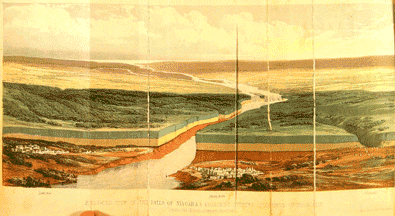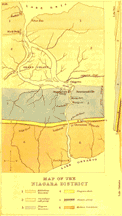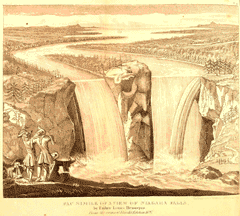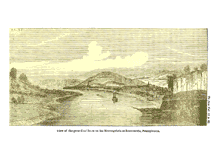CHAPTER XIV.
001
002
003
004
005
006
007
008
009
010
011
012
013
014
015 016
017
018
019
Dr. Channing. -- Agitation in Rhode Island. -- Armed Convention. -- Sail through Amboy Straits. -- Journey to Philadelphia and Baltimore. -- Harper's Ferry. -- Passage over the Alleghanies by National Road. -- Parallel Ridges. -- Absence of Drift. -- Structure and Origin of Appalachians. -- Theory of Subsidence and Contraction of Subterranean Fluid. -- Kentucky Farmers. -- Emigrants. -- Cumberland Coal Field. -- Clay with Stigmaria. -- Marine Shells in Coal-Measures near Frostburg. -- Wide Geographical Distribution of Fossil Coal.
Dr. Channing. -- Agitation in Rhode Island. -- Armed Convention. -- Sail through Amboy Straits. -- Journey to Philadelphia and Baltimore. -- Harper's Ferry. -- Passage over the Alleghanies by National Road. -- Parallel Ridges. -- Absence of Drift. -- Structure and Origin of Appalachians. -- Theory of Subsidence and Contraction of Subterranean Fluid. -- Kentucky Farmers. -- Emigrants. -- Cumberland Coal Field. -- Clay with Stigmaria. -- Marine Shells in Coal-Measures near Frostburg. -- Wide Geographical Distribution of Fossil Coal.
CHAPTER XV.
020
021
022
023
024
025
026
027 028
029
030
031
032
033
034
035
036
037
038
Alleghany Mountains. -- Union. -- Horizontal Coal Formation. -- Brownsville on the Monongahela. -- Facilities of Working Coal. -- Navigable Rivers. -- Great Future Resources of the Country. -- Pittsburg. -- Illinois Coal Field. -- Fossil Indian Corn. -- Indian Mounds near Wheeling. -- General Harrison on their high Antiquity. -- Dr. Morton on the aboriginal Indians. -- Remarks on the Civilisation of the Mexicans and other Tribes. -- Marietta. -- Silicified Trees or Psarolites of Ohio.Coal of Pomeroy. -- New Settlements. -- Cincinnati.
Alleghany Mountains. -- Union. -- Horizontal Coal Formation. -- Brownsville on the Monongahela. -- Facilities of Working Coal. -- Navigable Rivers. -- Great Future Resources of the Country. -- Pittsburg. -- Illinois Coal Field. -- Fossil Indian Corn. -- Indian Mounds near Wheeling. -- General Harrison on their high Antiquity. -- Dr. Morton on the aboriginal Indians. -- Remarks on the Civilisation of the Mexicans and other Tribes. -- Marietta. -- Silicified Trees or Psarolites of Ohio.Coal of Pomeroy. -- New Settlements. -- Cincinnati.
CHAPTER XVI.
039
040
041
042
043
044
045
046
047
048
049
Succession of Strata on the Ohio between Pomeroy and Cincinnati. -- Return up the Ohio to Rockville. -- Waverley Sandstone. -- Cliff Limestone. -- Denudation. -- Blue Limestone of Cincinnati. -- Lower Silurian Fossils. -- Limited Proportion of Silurian Species common to Europe and America. -- Great Development of Brachiopoda. -- Deep Sea Formations. -- Rarity of Silurian Land Plants. -- Silurian Fossil Fish.
Succession of Strata on the Ohio between Pomeroy and Cincinnati. -- Return up the Ohio to Rockville. -- Waverley Sandstone. -- Cliff Limestone. -- Denudation. -- Blue Limestone of Cincinnati. -- Lower Silurian Fossils. -- Limited Proportion of Silurian Species common to Europe and America. -- Great Development of Brachiopoda. -- Deep Sea Formations. -- Rarity of Silurian Land Plants. -- Silurian Fossil Fish.
CHAPTER XVII.
050
051
052
053
054
055
056
057
058
059
060
Alluvial Terraces at Cincinnati, and their Origin. -- Bones of the Elephant and Mastodon. -- Excursion to the Swamps of Big Bone Lick, in Kentucky. -- Noble Forest. -- Salt Springs. -- Buffalo Trail. -- Numerous Bones of Extinct Animals. -- Associated Freshwater and Landshells. -- Relative Age of Northern Drift, and Deposits with Bones of Mastodon on the Ohio.
CHAPTER XVIII.Alluvial Terraces at Cincinnati, and their Origin. -- Bones of the Elephant and Mastodon. -- Excursion to the Swamps of Big Bone Lick, in Kentucky. -- Noble Forest. -- Salt Springs. -- Buffalo Trail. -- Numerous Bones of Extinct Animals. -- Associated Freshwater and Landshells. -- Relative Age of Northern Drift, and Deposits with Bones of Mastodon on the Ohio.
061
062
063
064
065
066
067
068 069
070
Cincinnati. -- Journey across Ohio to Cleveland. -- New Clearings. -- Rapid progress of the State since the year 1800. -- Increase of Population in the United States. -- Political Discussions. -- German and Irish Settlers. -- Stump Oratory. -- Presidential Elections. -- Relative Value of Labour and Land.
Cincinnati. -- Journey across Ohio to Cleveland. -- New Clearings. -- Rapid progress of the State since the year 1800. -- Increase of Population in the United States. -- Political Discussions. -- German and Irish Settlers. -- Stump Oratory. -- Presidential Elections. -- Relative Value of Labour and Land.
CHAPTER XIX.
071
072
073 074
075
076
077
078
079
080
081
082 083
084
Cleveland. -- Ridges of Land and Gravel along the Southern coast of Lake Erie. -- Their Origin. -- Fredonia; streets lighted with natural Gas. -- Falls of Niagara. -- Burning Spring. -- Passing behind the Falls. -- Daguerreotype of the Falls. -- Boulder Formation of Whirlpool, and Valley of St. David's. -- Glacial polishing and Furrows. -- Influence of Icebergs on Drift.
Cleveland. -- Ridges of Land and Gravel along the Southern coast of Lake Erie. -- Their Origin. -- Fredonia; streets lighted with natural Gas. -- Falls of Niagara. -- Burning Spring. -- Passing behind the Falls. -- Daguerreotype of the Falls. -- Boulder Formation of Whirlpool, and Valley of St. David's. -- Glacial polishing and Furrows. -- Influence of Icebergs on Drift.
CHAPTER XX.
085
086
087
088
089
090
091
092
093
094 095
Mirage on Lake Ontario. -- Toronto. -- Excursion with Mr. Roy to examine the Parallel Ridges between Lakes Ontario and Simcoe. -- Correspondence of Level in their Base-lines over wide Areas. -- Origin of the Ridges. -- Lacustrine Theory. -- Hypothesis of Sand-banks formed under Water. -- Rapid Progress of the Colony. -- British Settlers unable to speak English.
Mirage on Lake Ontario. -- Toronto. -- Excursion with Mr. Roy to examine the Parallel Ridges between Lakes Ontario and Simcoe. -- Correspondence of Level in their Base-lines over wide Areas. -- Origin of the Ridges. -- Lacustrine Theory. -- Hypothesis of Sand-banks formed under Water. -- Rapid Progress of the Colony. -- British Settlers unable to speak English.
CHAPTER XXI.
096
097
098
099
100
101
102
103
104
105
106
107
108
109
110
111
112
<>
Kingston. -- Montreal. -- French Population and Language. -- Quebec. -- Soldiers. -- Deserters. -- Three Rivers. -- Scotch Emigrants. -- Distinctness of French and British Canadians. -- Large Military Force. -- American Sympathizers. -- Geolological Survey. -- Analogy in Structure of Canada and Scandinavia. -- Section at Falls of Montmore ncy. -- <>Uncomfortable position of lowest Fossiliferous Sandstone to Grfeiss. -- Supposed Monument of the Commencement of the Organic World. -- To what extent the Granitic Rocks are primary. -- <>Difficulty of establishing the Date of Metamorphic Action. -- <>Two Sources of popular error respecting the more abundant <>production of Hypogene Rocks at Remote Periods.
<>
<>
Kingston. -- Montreal. -- French Population and Language. -- Quebec. -- Soldiers. -- Deserters. -- Three Rivers. -- Scotch Emigrants. -- Distinctness of French and British Canadians. -- Large Military Force. -- American Sympathizers. -- Geolological Survey. -- Analogy in Structure of Canada and Scandinavia. -- Section at Falls of Montmore ncy. -- <>Uncomfortable position of lowest Fossiliferous Sandstone to Grfeiss. -- Supposed Monument of the Commencement of the Organic World. -- To what extent the Granitic Rocks are primary. -- <>Difficulty of establishing the Date of Metamorphic Action. -- <>Two Sources of popular error respecting the more abundant <>production of Hypogene Rocks at Remote Periods.
<>
CHAPTER XXII.
113
114
115 116
117
118
119 120
121
122
123
124
125
126
127 128
129
130
131
132
133
134
135
Glacial Furrows in the Valley of the St. Lawrence. -- Action of packed ice in the Canadian Rivers. -- Boulder Formation with and without Shells. -- Gannanoqui. -- Mountain of Montreal. -- Recent Shells in Drift more than 500 feet above the Sea. -- Lake St. Peter. -- Falls of Maskinongé. -- Deposit of Shells at Beaufort near Quebec. -- Agreement with Swedish Fossils. -- Shells in Boulder Formation of Lake Champlain. -- Burlington, Vermont. -- Fossils of Drift imply a colder climate. -- Scenery of Lake Champlain. -- Organic Remains of lowest Silurian Sandstone. -- Lingula. -- Vermont Mountains. -- Inns and Boarding-houses. -- Return to Boston.
Glacial Furrows in the Valley of the St. Lawrence. -- Action of packed ice in the Canadian Rivers. -- Boulder Formation with and without Shells. -- Gannanoqui. -- Mountain of Montreal. -- Recent Shells in Drift more than 500 feet above the Sea. -- Lake St. Peter. -- Falls of Maskinongé. -- Deposit of Shells at Beaufort near Quebec. -- Agreement with Swedish Fossils. -- Shells in Boulder Formation of Lake Champlain. -- Burlington, Vermont. -- Fossils of Drift imply a colder climate. -- Scenery of Lake Champlain. -- Organic Remains of lowest Silurian Sandstone. -- Lingula. -- Vermont Mountains. -- Inns and Boarding-houses. -- Return to Boston.
CHAPTER XXIII.
136
137
138
139
140
141
142
143
144
145
146
147
Halifax. -- Glacial Furrows in Nova Scotia. -- Difference of Climate of Halifax and Windsor. -- Tracts covered with Kalmia. -- Linnea borealis. -- High tides of the Bay of Fundy. -- The Bore. -- Recent deposits of Red Mud hardened in the Sun. -- Fossil Showers of Rain. -- Footprints of Birds, and casts of the same. -- Cracks caused by Shrinkage. -- Submerged Frost. -- Recent Glacial Furrows at Cape Blomidon. -- Loaded Ice. -- Ice-ruts in Mud.
CHAPTER XXIV.Halifax. -- Glacial Furrows in Nova Scotia. -- Difference of Climate of Halifax and Windsor. -- Tracts covered with Kalmia. -- Linnea borealis. -- High tides of the Bay of Fundy. -- The Bore. -- Recent deposits of Red Mud hardened in the Sun. -- Fossil Showers of Rain. -- Footprints of Birds, and casts of the same. -- Cracks caused by Shrinkage. -- Submerged Frost. -- Recent Glacial Furrows at Cape Blomidon. -- Loaded Ice. -- Ice-ruts in Mud.
[140] [Regarding mudflats in Nova
Scotia during the neap tides] "When I arrived in this region it was the
period of the lowest or neap tides, so that large areas, where the red
mud had been deposited, were laid dry, and in some spots had been
baking in a hot sun for ten days. The upper part of the mud had thus
become hard for a depth of several inches, and in its consolidated form
exactly resembled, both in colour and appearance, some of the red marls
of the New Red sandstone formation of Europe. The upper surface was
usually smooth, but in some places I saw it pitted over with small
cavities, which I was told were due to a shower of rain which fell
eight or ten days before, when the deposit was still soft. It perfectly
recalled to my mind those 'fossil showers' of which the markings are
preserved in some ancient rocks, and the origin of which was first
correctly explained to an incredulous public by Dr. Buckland in 1838.
... In addition to the smaller cavities de to rain, there are larger
ones, more perfectly circular, about the size of large currants, which
have been formed by air-bubbles in the mud.
... On the surface of the dried beds of red mud ... I observed many worm-like tracks, made by Annelides which burrow in the mud; and what was still more interesting to me, the distinct footmarks of birds....""
... On the surface of the dried beds of red mud ... I observed many worm-like tracks, made by Annelides which burrow in the mud; and what was still more interesting to me, the distinct footmarks of birds....""
148
149
150
151
152
153
154
155
156
157
158
159
160
161
162
163
164
165
166
167
168 169
170
171
Coal Formation of Nova Scotia. -- Productive Coal-Measures. -- Erect Fossil Trees in the Cliffs of the Bay of Fundy. -- Section from Minudie to the South Joggins. -- Ten buried Forests, one above the other. -- Connection of upright Trees with Seams of Coal. -- Stigmaria. -- Sigillaria. -- Evidence of Repeated Submergence of dry Land. -- Theory to explain the Evenness of the Ancient Surface.Pictou Coal Field. -- Bed of Erect Calamites, compared to those of St. Etienne, in France. -- List of Species of Nova Scotia Coal-plants. -- Four-fifth of these Fossils identified with European Species. -- Carboniferous Flora of the United States.
Coal Formation of Nova Scotia. -- Productive Coal-Measures. -- Erect Fossil Trees in the Cliffs of the Bay of Fundy. -- Section from Minudie to the South Joggins. -- Ten buried Forests, one above the other. -- Connection of upright Trees with Seams of Coal. -- Stigmaria. -- Sigillaria. -- Evidence of Repeated Submergence of dry Land. -- Theory to explain the Evenness of the Ancient Surface.Pictou Coal Field. -- Bed of Erect Calamites, compared to those of St. Etienne, in France. -- List of Species of Nova Scotia Coal-plants. -- Four-fifth of these Fossils identified with European Species. -- Carboniferous Flora of the United States.
CHAPTER XXV.
172
173 174
175
176
177
178
179
180
181
182 183
184
185
186
187
Lower Carboniferous or Gypsiferous Formation of Nova Scotia. -- Why formerly considered as newer than the productive Coal. -- Determination of its true age. -- Sections near Windsor. -- Supposed Reptilian Footsteps. -- Section on the Shubenacadie. -- Large Masses of Gypsum. -- Their Origin. -- Volcanic Action contemporaneous with Nova Scotia Coal Measures. -- Limestone with Marine Shells. -- Table of Organic Remains of the Carboniferous Limestone of Nova Scotia and Island of Cape Breton.
Lower Carboniferous or Gypsiferous Formation of Nova Scotia. -- Why formerly considered as newer than the productive Coal. -- Determination of its true age. -- Sections near Windsor. -- Supposed Reptilian Footsteps. -- Section on the Shubenacadie. -- Large Masses of Gypsum. -- Their Origin. -- Volcanic Action contemporaneous with Nova Scotia Coal Measures. -- Limestone with Marine Shells. -- Table of Organic Remains of the Carboniferous Limestone of Nova Scotia and Island of Cape Breton.
CHAPTER XXVI.
188
189
190
191
192
193
194 195
196
197
Progress and Resources of Nova Scotia. -- Highland Settlers. -- Timber Duties. -- Cobequid Hills. -- Conflagration of Forests. -- Albion Mines. -- Humming Birds. -- Estuary of the Shubenacadie. -- Stakes cut by Beavers. -- Promotion of Science. -- Social Equality. -- Nova Scotians "going home." -- Return to England.
Progress and Resources of Nova Scotia. -- Highland Settlers. -- Timber Duties. -- Cobequid Hills. -- Conflagration of Forests. -- Albion Mines. -- Humming Birds. -- Estuary of the Shubenacadie. -- Stakes cut by Beavers. -- Promotion of Science. -- Social Equality. -- Nova Scotians "going home." -- Return to England.
Plates and
Maps.
| Plate
(click on plate for image at 100 ppi.) |
Description |
 Plate I. Bird's-eye view of the Falls of Niagara. Frontisepiece of Vol. I. |
198 |
| [missing] Plate II. Geological Map of the United States, Canada, &c. Frontisepiece of Vol. II. |
200 |
 Plate III. Map of the Niagara District. |
219 |
 Plate IV. Facsimile of a view of Niagara Falls. |
220 |
 Plate V. Fossil mammalian remains from tertiary strata of Martha's Vineyard, Massachusetts. |
220 |
 Plate VI. View of the great coal seem on the Monongahela at Brownsville, Pennsylvania. (cf. Vol II. p. 22) |
221 |
 Plate VII. Recent footprints of birds, the Sandpiper, natural size. |
221 |



